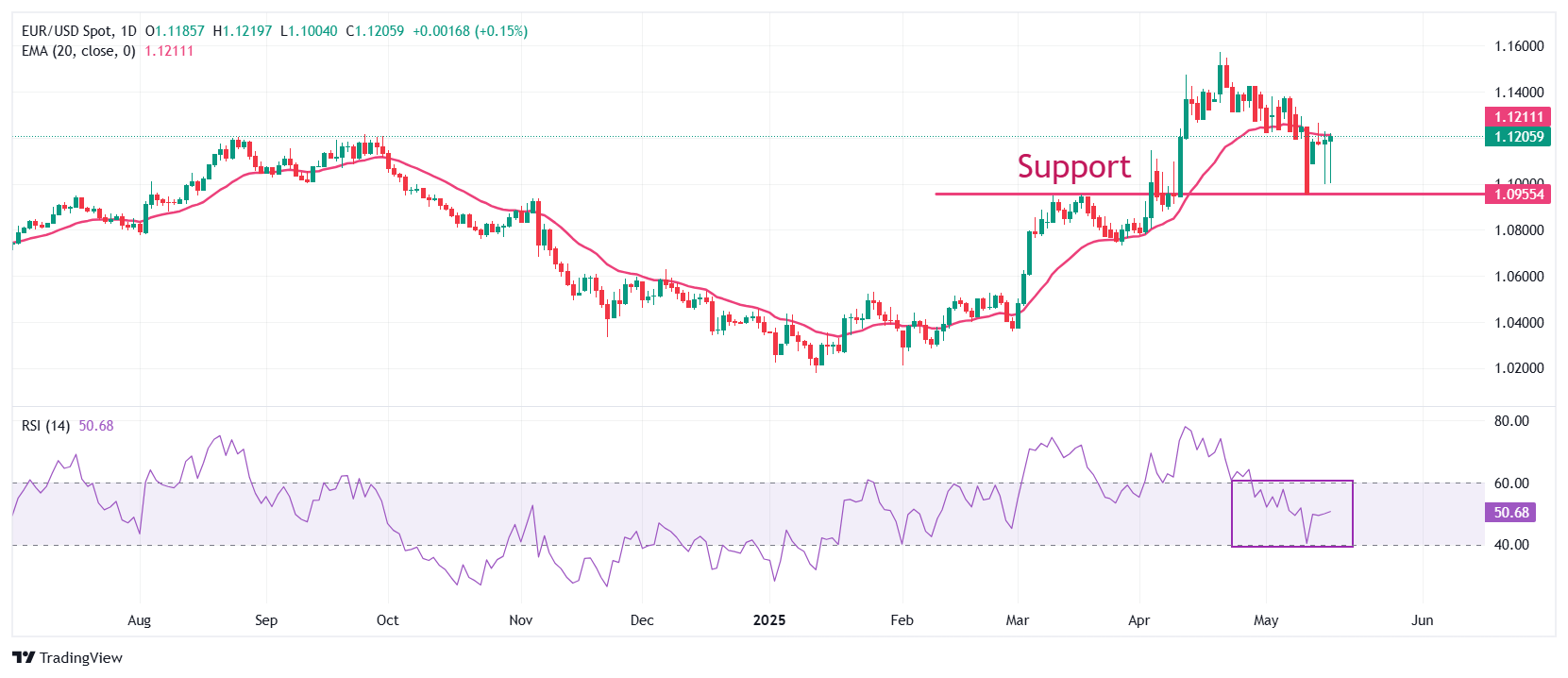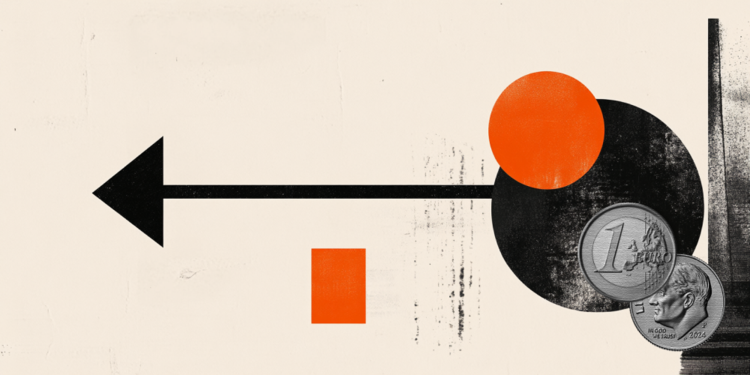- EUR/USD is slightly higher to near 1.1200, while the US Dollar flattens ahead of US Michigan survey data.
- US consumer and producer inflation, and Retail Sales remained soft in April.
- ECB’s Kazaks argued in favor of further interest rate cuts.
EUR/USD trades slightly higher to near 1.1200 during North American trading hours on Friday. The major currency pair edges higher, while the US Dollar (USD) flattens after recovering initial losses ahead of the release of the flash United States (US) consumer sentiment and inflation expectations data for May.
The US Dollar Index (DXY), which tracks the Greenback’s value against six major currencies, wobbles around 100.80. Earlier in the day, the Greenback faced selling pressure, tracking a sharp decline in US bond yields due to soft United States (US) Producer Price Index (PPI) and Retail Sales data on Thursday. 10-year US Treasury yields are down over 3% to near 4.40%, at the press time, from their monthly high of 4.55% posted on Thursday.
The economic data showed on Thursday that the producer inflation, as measured by the PPI, declined unexpectedly in April, and Retail Sales barely grew. The notable decline of 0.7% in services prices led to deflation in the PPI, while the growth in goods prices remained flat. Meanwhile, Retail Sales rose at a moderate pace of 0.1%, compared to a robust growth of 1.5% in March. The data showed that demand for automobiles declined as households postponed their demand in the wake of a hike in selling prices by car dealers to offset the impact of tariffs imposed by US President Donald Trump on foreign cars in March.
This week, the US Consumer Price Index (CPI) data for April also grew at a slower-than-expected pace. Theoretically, soft US consumer and producer inflation boosts expectations of interest rate cuts by the Federal Reserve (Fed). However, traders have not raised dovish bets as consumer inflation expectations remain higher due to the fallout of new economic policies by US President Donald Trump.
According to the CME FedWatch tool, the probability for the Fed to leave rates steady in the range of 4.25%-4.50% in the June and July meetings is 91.8% and 61.4%, respectively.
While Washington and Beijing have agreed to lower tariffs by 115% for 90 days and are aiming for a series of negotiations to avoid any escalation in the trade war, Fed officials believe that the current rate of tariffs is still high enough to prompt inflation.
Earlier this week, Chicago Fed Bank President Austan Goolsbee said, “Tariffs are still three to five times higher than what they were before, so it is going to have a stagflationary impulse on the economy. It’s going to make growth slower and make prices rise.”
Daily digest market movers: EUR/USD gives up majority of initial gains as US Dollar revives
- EUR/USD is marginally higher as the Euro (EUR) is broadly steady against its peers on Friday. The major currency remains calm despite traders remaining increasingly confident that the European Central Bank (ECB) will reduce interest rates again in the monetary policy meeting next month.
- Factors contributing to solid ECB dovish bets are confidence that the Eurozone inflation is on track to return to the central bank’s target of 2% this year, and the economic outlook is grim due to global uncertainty.
- Several ECB officials have argued in favor of continuing interest rate reduction. During European trading hours, ECB Governing Council member Martins Kazaks guided a dovish monetary policy outlook by saying that there may still be a “couple” of reductions in the deposit rate this year from its current level of 2.25%, Bloomberg reported. However, Kazaks cautioned that policymakers shouldn’t hurry and adopt a “meeting by meeting” approach amid the unclear global trade situation.
- On the economic front, Eurozone Q1 Gross Domestic Product (GDP) data has been revised lower, while Employment Change has held up. The data showed on Thursday that the Eurozone economy grew at a slower pace of 0.3%, compared to the preliminary estimate and the prior release of 0.4%. Year-on-year, the GDP growth remained 1.2%, as expected. Meanwhile, the Employment Change in the January-March period has come in higher at 0.3% quarter-on-quarter, compared to flash estimates and the former reading of 0.1%.
Euro PRICE Today
The table below shows the percentage change of Euro (EUR) against listed major currencies today. Euro was the strongest against the Swiss Franc.
| USD | EUR | GBP | JPY | CAD | AUD | NZD | CHF | |
|---|---|---|---|---|---|---|---|---|
| USD | -0.06% | 0.23% | -0.04% | 0.03% | -0.06% | -0.27% | 0.26% | |
| EUR | 0.06% | 0.29% | 0.02% | 0.09% | 0.02% | -0.20% | 0.32% | |
| GBP | -0.23% | -0.29% | -0.27% | -0.20% | -0.27% | -0.49% | 0.04% | |
| JPY | 0.04% | -0.02% | 0.27% | 0.07% | -0.03% | -0.25% | 0.30% | |
| CAD | -0.03% | -0.09% | 0.20% | -0.07% | -0.11% | -0.29% | 0.25% | |
| AUD | 0.06% | -0.02% | 0.27% | 0.03% | 0.11% | -0.21% | 0.31% | |
| NZD | 0.27% | 0.20% | 0.49% | 0.25% | 0.29% | 0.21% | 0.53% | |
| CHF | -0.26% | -0.32% | -0.04% | -0.30% | -0.25% | -0.31% | -0.53% |
The heat map shows percentage changes of major currencies against each other. The base currency is picked from the left column, while the quote currency is picked from the top row. For example, if you pick the Euro from the left column and move along the horizontal line to the US Dollar, the percentage change displayed in the box will represent EUR (base)/USD (quote).
Technical Analysis: EUR/USD struggles to move above 1.1200

EUR/USD rises to near 1.1200 on Friday. However, the near-term outlook of the pair is still uncertain as the 20-day Exponential Moving Average (EMA) is acting as a key barrier around 1.1210.
The 14-period Relative Strength Index (RSI) recovers strongly to 50.00 after sliding to near 40.00, suggesting indecisiveness among traders.
Looking up, the April 28 high of 1.1425 will be the major resistance for the pair. Conversely, the March 18 high of 1.0955 will be a key support for the Euro bulls.

